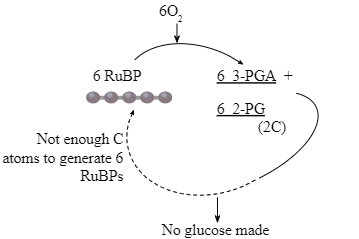Photorespiration is considered a wasteful process for the following reasons –
- It inhibits photosynthesis by diverting RuBisCO activity away from carbon fixation.
- It decreases the production of glucose and oxygen, which are important products of photosynthesis.
- It consumes ATP instead of producing it, resulting in a loss of energy for the plant.
- It leads to a loss of fixed carbon through the release of carbon dioxide.
Table of Contents
Detailed Justification – “Photorespiration is a wasteful process”
Inhibition of Photosynthesis
- Photorespiration occurs when the enzyme RuBisCO mistakenly takes up oxygen instead of carbon dioxide during the Calvin cycle of photosynthesis.
- This oxygenation reaction inhibits the normal process of photosynthesis by diverting the activity of RuBisCO from carbon fixation.
- As a result, the production of glucose and other organic compounds, which are important products of photosynthesis, is reduced.
Decrease in Photosynthetic Products
- Oxygenation of RuBisCO leads to a decrease in the production of glucose and oxygen, both of which are important products of photosynthesis.
- Glucose serves as a source of energy and as a building block for plant growth and development.
- Oxygen is released as a by-product of photosynthesis and is essential for the survival of organisms that depend on oxygen for respiration.
ATP Utilisation
- During photorespiration, ATP is consumed instead of being produced, making it an energy-consuming process.
- The breakdown of glucose during normal respiration produces ATP, the energy currency of cells.
- However, during photorespiration, ATP is consumed to release the carbon dioxide that is produced during the oxygenation reaction.
- This represents a wasteful utilisation of ATP that could have been used for other important cellular processes.
Also Check – Photorespiration: The Futile Cycle?
Loss of Fixed Carbon
- Photorespiration leads to the release of carbon dioxide instead of fixing it in organic compounds.
- The oxygenation reaction produces a toxic compound called phosphoglycolate, which is then converted to glycolate and other compounds during photorespiration.
- These reactions result in the loss of fixed carbon, reducing the efficiency of carbon dioxide utilisation and decreasing the net carbon gain of the plant.
